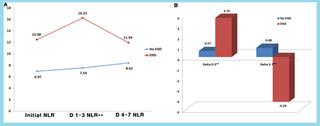PLOS ONE ( IF 3.7 ) Pub Date : 2018-03-16 , DOI: 10.1371/journal.pone.0194286 Ki-Woong Nam , Tae Jung Kim , Chi Kyung Kim , Heejung Mo , Han-Yeong Jeong , Min Kyoung Kang , Moon-Ku Han , Sang-Bae Ko , Byung-Woo Yoon

|
Background
Ischemic stroke patients with active cancer frequently experience early neurological deterioration (END); however, the predictors of END are not well studied. The neutrophil to lymphocyte ratio (NLR) has recently been described as a predictor of poor outcomes in cancer and stroke. However, its role in cancer-related stroke has not been addressed.
Aim
We aimed to evaluate the association between the NLR and END in cancer-related stroke patients.
Methods
We included 85 cryptogenic stroke patients with active cancer. END was defined as an increase ≥ 4 on the total National Institutes of Health Stroke Scale (NIHSS) score within 72 hours of admission. The NLR was calculated as the ratio of the absolute neutrophil count to the absolute lymphocyte count. We obtained the NLR during the following three periods: at admission, 1–3 days after admission (D 1–3 NLR) and 4–7 days after admission (D 4–7 NLR).
Results
END occurred in 15 (18%) of the 85 patients. END was significantly associated with the initial NIHSS score, infarction volume, and the D 1–3 NLR. In multivariate analysis, a higher D 1–3 NLR, measured before END events, remained an independent predictor of END [adjusted odds ratio = 2.78, 95% confidence interval = 1.09–7.08, P = 0.032]. In terms of temporal changes in the NLR, the END group showed a tendency toward temporal increase in the NLR at D 1–3 (P = 0.061) with subsequent decrements in the D 4–7 NLR (P = 0.088), while the non-END group showed no significant changes in the NLR between periods.
Conclusions
This study demonstrated that a higher NLR could predict END events in cryptogenic stroke patients with active cancer. However, the results should be confirmed in further large prospective studies.
中文翻译:

患有活动性癌症的隐源性卒中中性粒细胞与淋巴细胞比例的时间变化和神经系统进展
背景
患有活动性癌症的缺血性卒中患者经常会出现早期神经功能恶化(END);但是,END的预测因素尚未得到很好的研究。最近,嗜中性粒细胞与淋巴细胞的比率(NLR)被描述为癌症和中风预后不良的预测指标。然而,其在癌症相关中风中的作用尚未得到解决。
目的
我们旨在评估与癌症相关的卒中患者的NLR和END之间的关联。
方法
我们纳入了85名患有活动性癌症的隐源性中风患者。END的定义是入院72个小时内,美国国立卫生研究院卒中量表(NIHSS)总得分≥4。计算NLR为绝对嗜中性粒细胞计数与绝对淋巴细胞计数之比。我们在以下三个时期获得了NLR:入院时,入院后1-3天(D 1-3 NLR)和入院后4-7天(D 4-7 NLR)。
结果
END发生在85名患者中的15名(18%)中。END与最初的NIHSS评分,梗死体积和D 1-3 NLR显着相关。在多变量分析中,在END事件发生之前测得的较高的D 1-3 NLR仍是END的独立预测因子[调整后的优势比= 2.78,95%置信区间= 1.09–7.08,P = 0.032]。在NLR的时间变化方面,END组在D 1–3时NLR呈暂时性增加趋势(P = 0.061),随后在D 4–7 NLR中又下降(P = 0.088)。 -END组在各时期之间的NLR中无明显变化。
结论
这项研究表明,较高的NLR可以预测患有活动性癌症的隐源性卒中患者的END事件。但是,结果应在进一步的大型前瞻性研究中得到证实。



























 京公网安备 11010802027423号
京公网安备 11010802027423号